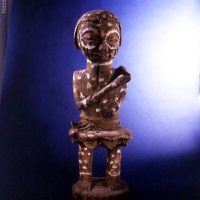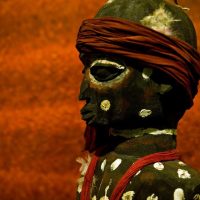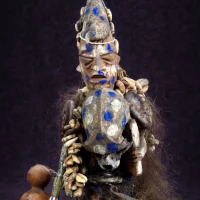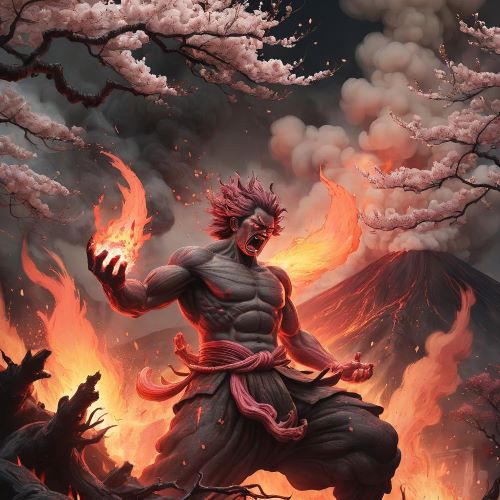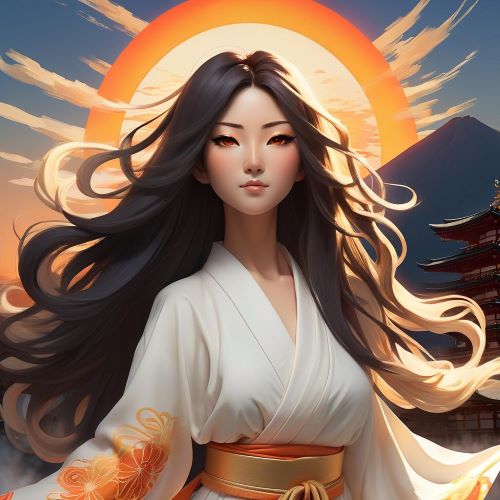Izanami : The Creator Goddess
Listen
At a glance
| Description | |
|---|---|
| Origin | Japanese Mythology |
| Classification | Gods |
| Family Members | Izanagi (Husband), Amaterasu (Daughter) |
| Region | Japan |
| Associated With | Creation, Death |
Izanami
Introduction
Japanese mythology boasts a wealth of captivating deities and mystical tales, each contributing to the nation’s cultural heritage. Among these divine beings, Izanami stands out as particularly intriguing and enigmatic. Revered as the goddess of creation and death, her story intertwines with Japan’s creation myth, shedding light on the origins of the world and the cycle of life and death. Alongside her husband Izanagi, Izanami holds a pivotal role in Japanese mythology. Honored with titles like Izanami-no-Mikoto, meaning “She-who-invites” or “Female-who-invites,” she embodies a captivating duality. She is both a creator deity, credited with birthing the Japanese islands and numerous gods, and a figure associated with death, reigning over the underworld. Izanami, formally known as Izanami-no-Mikoto, stands as a central and multifaceted figure in Japanese mythology, embodying both creation and death, rendering her a deity of great complexity and power.
Physical Traits
In Shinto tradition, Izanami’s appearance remains elusive, with no definitive depictions. Early texts like the Kojiki and Nihon Shoki provide scant details, painting a picture of a youthful and beautiful goddess befitting her role as a creator. This portrayal contrasts starkly with the later transformation she undergoes upon descending into the underworld, Yomi, where she takes on a monstrous and decaying form, embodying the darkness and dread of death.
The traditional representations of Izanami depict her as a serene and graceful deity, exuding wisdom and power. Clad in elegant robes, her flowing hair and gentle features convey her beauty, which transcends mere physical attributes to symbolize creation and fertility. Artists capture her ethereal essence, portraying her with flowing robes and a tranquil countenance, reflecting her connection to the natural world and her role as a creator goddess.
Family
Izanami’s primary familial tie is with her brother-husband, Izanagi, a union reflecting the primal essence of these deities. Together, they embark on the monumental task of world creation, birthing pivotal gods such as the sun goddess Amaterasu, the moon god Tsukuyomi, and the storm god Susanoo. However, their blissful partnership shatters with the birth of Kagutsuchi, the fire god, who fatally consumes Izanami in his fiery emergence. Overwhelmed with grief, Izanagi ventures into Yomi, the underworld, in a desperate attempt to retrieve her. Izanami’s role in Japanese mythology extends beyond her individual presence, deeply intertwined with other significant deities, particularly her brother and consort, Izanagi. Together, they are pivotal in shaping the Japanese archipelago and populating it with divine beings, marking the genesis of the mythological pantheon.
Other names
Izanami’s principal appellation, Izanami-no-Mikoto, carries profound symbolism. “Mikoto,” an honorific reserved for deities, underscores her elevated stature within the pantheon. “Izanami” itself holds significance, translating to “She-who-invites” or “Female-who-invites,” potentially alluding to her role in the genesis of life and the invitation of souls into existence. However, following her transformation within the realm of Yomi, she adopts a formidable new moniker: Yomi-no-Oguchi (Ruler of Yomi) or Yomochi-no-Kami (Deity of Yomi), emblematic of her sovereignty over the underworld and her association with the realm of death.
While Izanami remains the most widely recognized name for this deity, various other epithets and titles are attributed to her in different contexts and regions. In certain accounts, she is revered as Izanami-no-Mikoto, accentuating her divine status. Moreover, regional disparities give rise to diverse interpretations of her character, resulting in the attribution of differing names and epithets reflective of her multifaceted role in Japanese mythology. The variations in her name, such as “Izanami-no-Kami” and “Izanami-no-Mikoto,” offer nuanced insights into her nature, with each iteration emphasizing distinct facets of her creative and nurturing essence.
Powers and Abilities
As the goddess of both creation and death, Izanami’s abilities reflect her dualistic nature, encompassing a wide spectrum of powers. She is lauded for shaping Japan’s landscape and animating its inhabitants, embodying her role as a creator deity. Yet, her dominion extends beyond the realm of life, reaching into the depths of death, where she governs over departed souls and orchestrates the cycle of rebirth. One of Izanami’s paramount abilities lies in her mastery over the forces of life and death. She possesses the authority to grant life to the living and guide the souls of the deceased to their afterlife destinations. This dual aspect underscores the cyclical essence of existence, where creation and destruction interweave in an eternal cycle of regeneration.
In tandem with Izanagi, she wields the power to generate life, fostering the birth of the Japanese islands and an array of deities. Additionally, she is depicted as exerting influence over the natural world. In certain narratives, she and Izanagi employ a jeweled spear to churn the primeval sea, bringing forth the inaugural landmass. This association with the sea links her to the wellspring of life, echoing creation myths worldwide. However, her descent into Yomi marks a pivotal transformation. She metamorphoses into the epitome of death, reigning over the underworld and commanding authority over the departed.
Some interpretations even posit that she gains dominion over illness and the perpetual cycle of life and death itself. Izanami’s formidable influence extends over both realms, as she partook in the world’s creation by stirring the sea with the divine spear, Amenonuhoko. Nonetheless, tragedy struck during the birth of her child, precipitating her descent into Yomi, the realm of the deceased.
Modern Day Influence
Izanami’s ancient mythology continues to exert a profound influence in contemporary Japan and beyond, permeating literature, art, and popular culture as a testament to her enduring significance as a symbol of creation and renewal. In literary realms, Izanami’s mythological saga inspires a myriad of fictional works and poetic compositions, offering fertile ground for the exploration of themes such as mortality, the passage of time, and the mysteries of existence. Authors and poets draw upon her narrative to weave compelling tales that delve into the depths of the human condition.
Within the realm of art, Izanami’s visage takes on various forms, spanning from traditional renditions in paintings and sculptures to contemporary interpretations in digital media. Artists endeavor to capture her ethereal beauty and spiritual essence, inviting viewers to contemplate the profound meanings encapsulated within her mythological persona. In popular culture, Izanami’s influence manifests across diverse entertainment mediums, including films, video games, and anime. Characters inspired by her mythological archetype populate myriad narratives, enriching the tapestry of storytelling and imagination.
Izanami’s legacy remains deeply ingrained within Japanese culture, as evidenced by her prominent stature in Shinto mythology, where she features in numerous creation myths and rituals. Shrines dedicated to her, often in conjunction with Izanagi, dot the landscape of Japan, serving as focal points for reverence and contemplation. Moreover, her narrative has permeated Japanese popular culture, with appearances in video games, anime, and manga, depicting her as a multifaceted and potent character whose image oscillates between beauty and terror, mirroring the inherent duality of her essence.
Beyond mere entertainment, Izanami’s mythos holds profound significance in elucidating Japanese conceptions of death and the afterlife. Yomi, the underworld she governs, transcends the notion of eternal damnation, serving instead as a realm for the departed. Izanami’s transformative journey underscores the cyclical nature of life and death, symbolizing the inevitable decay following creation. However, within this cycle lies the potential for rejuvenation, exemplified by Izanagi’s endeavors to engender new life subsequent to encountering his metamorphosed spouse.
Izanami’s legacy extends far beyond the confines of ancient mythology, resonating as a poignant emblem of life’s cyclical rhythms, wherein creation and dissolution intertwine seamlessly. Her enduring narrative continues to inspire artists, writers, and spiritual seekers alike, serving as a poignant reminder of life’s impermanence and the imperative of maintaining equilibrium amidst its ever-evolving flux.
Related Images
Frequently Asked Questions
What is lorem Ipsum?
I am text block. Click edit button to change this text. Lorem ipsum dolor sit amet, consectetur adipiscing elit. Ut elit tellus, luctus nec ullamcorper mattis, pulvinar dapibus leo.
What is lorem Ipsum?
I am text block. Click edit button to change this text. Lorem ipsum dolor sit amet, consectetur adipiscing elit. Ut elit tellus, luctus nec ullamcorper mattis, pulvinar dapibus leo.
What is lorem Ipsum?
I am text block. Click edit button to change this text. Lorem ipsum dolor sit amet, consectetur adipiscing elit. Ut elit tellus, luctus nec ullamcorper mattis, pulvinar dapibus leo.
What is lorem Ipsum?
I am text block. Click edit button to change this text. Lorem ipsum dolor sit amet, consectetur adipiscing elit. Ut elit tellus, luctus nec ullamcorper mattis, pulvinar dapibus leo.
What is lorem Ipsum?
I am text block. Click edit button to change this text. Lorem ipsum dolor sit amet, consectetur adipiscing elit. Ut elit tellus, luctus nec ullamcorper mattis, pulvinar dapibus leo.


